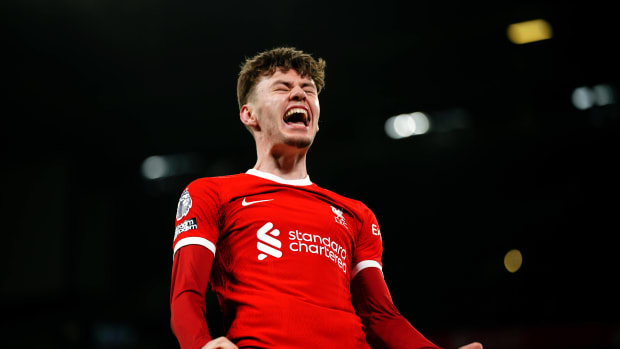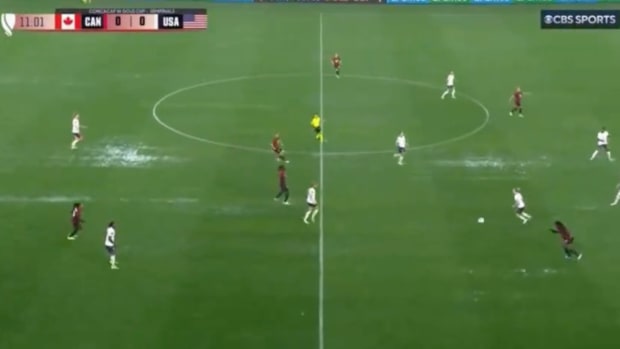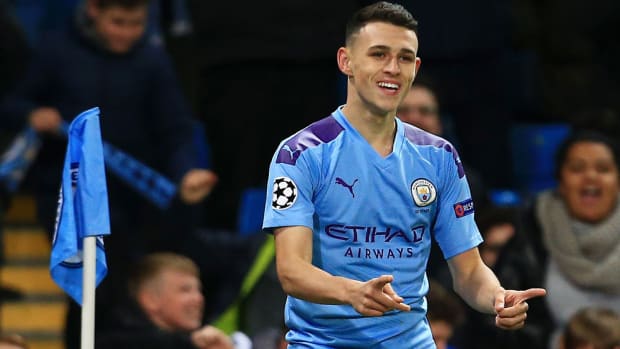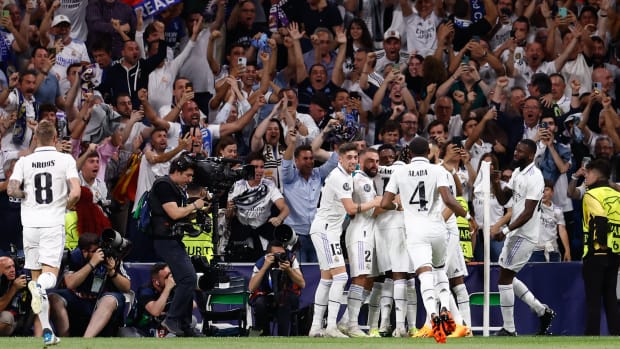As Blame Game Continues Over Jonathan Gonzalez's Decision, U.S. Soccer Denies Neglect
The inevitable (and for many north of the border, infuriating) became official on Thursday.
Jonathan Gonzalez’s request to transfer his international footballing allegiance from the USA to Mexico was rubber-stamped by FIFA, clearing the way for the 18-year-old Monterrey midfielder to be called up for El Tri's friendly against Bosnia-Herzegovina next week. The one-time-only switch also ensures Gonzalez, a Sonoma County, California, native who was capped more than two dozen times by various U.S. youth national teams, will never again represent the country of his birth.
The U.S. Soccer Federation has won its fair share of recruiting battles for dual-national players, but it lost the one for Gonzalez—a member of last season’s Liga MX “11 ideal”—in large part because it didn’t realize it was in one. Whether that’s an indictment of an organization that allegedly undervalues or overlooks Latino players and Liga MX, or whether it’s simply a result of circumstances surrounding this particular midfielder and these two national teams at this unique moment in time, the blowback has been fierce.
Already reeling from the failure to qualify for the 2018 World Cup and facing an uncertain future with an outgoing president and interim national team coach, the USSF has born the brunt of the blame.
“We’re an easy target, and I think this is another bullet in the gun,” Dave Sarachan said.
The contrast between Sarachan’s winter and Gonzalez’s winter is significant. The latter has returned to Monterrey’s starting lineup and is targeting his first senior cap, not to mention a seat on El Tri’s flight to Russia. Sarachan, meanwhile, is trying to maintain the U.S. national team’s pulse at a January camp full of untested internationals preparing for Sunday’s exhibition against Bosnia, and then a year-and-a-half of friendlies and potential CONCACAF League of Nations games after that.
When Sarachan, the interim USA manager, announced his January camp squad, it was Gonzalez’s absence that captured the headlines. The federation’s failure to secure the services of a player who’d been in its developmental pipeline for more than four years has been the subject of fierce debate and for some critics, is a sign that a national reckoning is required. For Sarachan, that debate has veered off course. He believes anger has obscured the facts.
“The disturbing part of all of this is the inaccuracies that I hear and read along with—being an older guy and a little bit old-school, I always thought journalists and people in the media would do their due diligence in terms of sources, like talking to people on both sides of the aisle,” Sarachan told SI.com from camp in Carson, California. “I’m on the inside—not on the inside to the extent that I coached Jonathan Gonzalez. But I know people on my staff and people that have and I know the other side of the story, and that’s the part people don’t hear.”
Sarachan claims that Gonzalez was valued, and that he was part of U.S. Soccer’s long-term plans. Whether or not the federation made Gonzalez feel the opposite—and if so, how—obviously is at the core of the criticism.
But Sarachan insists the player was on the national team’s radar. One month after turning 18, Gonzalez was one of coach Tab Ramos’s final cuts from the U-20 World Cup squad that made the quarterfinals in South Korea. Sarachan told SI.com that Ramos remained “in constant communication,” with Gonzalez, who joined the Monterrey academy in 2014 after declining the chance to go into residency with the U.S. U-17s. Nevertheless, Gonzalez continued to play with the U-17s before graduating to the U-20s, and further advancement seemed inevitable once he made his first-team debut for Los Rayados last summer. The USA, then coached by Bruce Arena, didn’t have the luxury of experimenting during World Cup qualifying. But once that ended and Arena resigned, the November friendly in Portugal offered an opportunity to call up Gonzalez—albeit one that wouldn’t tie him permanently to the USA.
The Most Intriguing Elements of USMNT's 2018 January Camp
It’s at this point that Sarachan enters the story, and it’s here that some believe Gonzalez may have been lost. There were 21 men invited to Portugal, including five uncapped players and four teenagers. But no one whose team remained active in MLS or Liga MX play was asked to fly across the Atlantic for a friendly. That ruled out Gonzalez, Sarachan said. There was always January camp. And if Monterrey didn’t release him this month as expected, Sarachan and his staff could look toward the FIFA window in March.
No one at U.S. Soccer informed Gonzalez that he wouldn’t be going to Portugal. Sarachan said the pool of potential call-ups numbered around 70, and that not every player who doesn’t make a given team is notified.
“You build certain relationships with people and so, for guys like Michael Bradley or Jozy Altidore or Clint Dempsey and all the veteran guys, I didn’t feel the need that I had to call them,” Sarachan explained. “Tab told me he was in constant communication with Jonathan, and being a youth player and Tab’s role as youth technical director, I felt we had that base covered and I didn’t feel I had to make the call to all the different players. I didn’t have a relationship personally with him, and others in the federation did and others had stayed in touch with him.”
Is it the national team coach’s—or the interim national team coach’s—job to build that relationship with an 18-year-old youth player? Perhaps it will be going forward, but it’s worth noting that Mexico coach Juan Carlos Osorio wasn’t Gonzalez’s primary recruiter. It was Dennis te Kloese, the Mexican federation’s director of national teams. There is no analogous position at the USSF. Te Kloese can spend time evaluating the big picture and building for the long term rather than focusing on the granular or day-to-day, and if there’s are lessons to be learned from Gonzalez’s departure, this may be one of them. Gonzalez didn’t slip through the cracks as a youth player. U.S. Soccer was on him early. He slipped away once he turned pro.
“To my knowledge, no,” Sarachan said when asked if he was aware that FMF had launched its pursuit of Gonzalez last fall. “There was nobody that pulled me aside and said, ‘By the way, we have a chance to lose this kid.’ All indications were that he had shown all the signs that his allegiance was still with the U.S. national team, and all throughout his youth his played for us—around 30 times.”
Sarachan formally invited Gonzalez to January camp, but there was no reply. By then, the tide had turned.
“Jonathan hit a hot stretch obviously with Monterrey and was starting to become a big part of things with them,” Sarachan said. “He was living in their environment. He was under their umbrella. Whether it was Monterrey or the Mexican federation, they had home-court advantage and they put a full-court press on, and he came to that conclusion. And it wasn’t for what I’ve been reading, whether it was bullying or neglect or a lack of respect or all that. Obviously, Mexico pushed hard and they had a lot to offer in their minds, and he chose.”
The chorus claiming that bullying, neglect and/or disrespect factored into Gonzalez’s decision has crystallized around ESPN’s Herculez Gomez, a former USA player, and Alianza de Futbol co-founder Brad Rothenberg, whose company attracts Latino players and scouts to its showcase tournaments.
Rothenburg, the son of former USSF president Alan Rothenberg, claimed the federation consistently fails to properly scout or recruit Latino players, that it ignores unconventional and unaffiliated development pathways, and that it’s insensitive to the cultural complexity of dual-national players and families “who feel no connection to U.S. Soccer or Major League Soccer.” Gomez, citing a conversation with Gonzalez’s father, called out national team scout Thomas Rongen for misrepresenting his contact with the Gonzalez family, as well as U-17 coach Richie Williams for allegedly issuing a 10-minute "take it or leave it" decision deadline when inviting the player to U.S. Soccer's residency program in December 2013.
Williams denied there was an out-of-the-blue ultimatum, telling Sirius XM radio that communication with the family was open and positive. The coach cited an email from Gonzalez’s mother that indicated Jonathan was “excited to get the invitation,” and that after his parents requested and received a couple extra days to determine their son would stay in Monterrey, Williams continued to call the player in to U-17 events.
There clearly is a (mis)perception issue on both sides. Whether Gonzalez felt undervalued and if so, why and for how long, is one key component of a conversation that’ll have to be held at all levels of U.S. Soccer once new leadership is in place next month. Outreach and access can always get better, and it’s clear following the World Cup qualifying failure that a new technical framework must be considered. For Gonzalez, the cultural piece is significant and certainly could’ve been a factor in his decision. But it’s also true that playing for Mexico, at this point, is an understandable and potentially smart call. He makes his living there, and he’s opted for a federation with a clearer direction and structure, not to mention a spot at the World Cup.
Christian Ramirez's USMNT Call-Up a Landmark Moment After His Family's Sacrifice
“He had this huge buffet of opportunities and options put in front of him, of course with the World Cup and maybe Osorio putting something in his ear about being part of it. I don’t know. But the fact that we’re not going to be at the dance, yes, as far as timing, I think that had a lot do with it,” Sarachan said.
The rest, from player development and scouting to technical personnel, he added, “will be a huge agenda item for the next [USSF presidential] administration … Can it be better? Should it be better? Absolutely.” But like Ramos, Williams and others at the federation, Sarachan vehemently denied that Gonzalez was ignored or unappreciated. The timing was unfortunate, he said—from missing out on the U-20 World Cup to the November friendly and his quick climb up the Monterrey depth chart—and in the end, U.S. Soccer simply didn’t anticipate the “full-court press” Gonzalez would receive. There could’ve been more calls or visits. But there was no contemplation of the worst-case scenario.
Ramos thought he’d done enough. Gonzalez was a U.S. player. Ramos told Goal.com, “I’ve stayed in touch with him over the last six months. You can ask him about the relationship that we have. If at this moment he felt like Mexico is the right place for him for the rest of his career, then at that point there’s only so much you can do.”
And Sarachan was eyeing the FIFA window in March. There was time, until there wasn’t.




